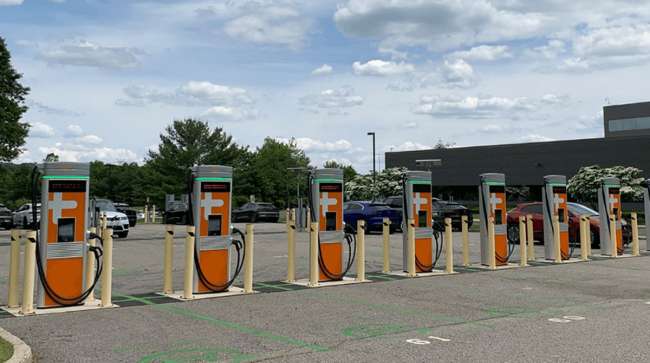Staff Reporter
Utah to Lower Gas Tax, Impose EV Charging Tax

[Stay on top of transportation news: Get TTNews in your inbox.]
Starting in January, people powering up electric vehicles at commercial charging stations in Utah will have to pay a 12.5% tax and gas prices will drop July 1 due to new laws signed by Gov. Spencer Cox.
Cox announced the new measures among transportation tax amendments in House Bill 301 during a ceremonial signing April 18 of 10 new laws “focused on smart growth.”
The tax amendments will lower gas taxes by 2 cents per gallon as of July 1 and eventually stagger increases through 2028, raise vehicle registration fees by $7 and impose the new EV charging station tax.
Chief sponsor of HB 301 was state Rep. Mike Schultz (R), who explained to lawmakers in March during the 2023 General Session that lowering the gas tax would provide short-term relief to Utah residents experiencing inflation and higher-than-anticipated gas taxes.

Schultz
In January, the state’s gas tax had an automatic increase of 4.5 cents to 36.4 cents per gallon for gas and diesel due to a law enacted in 2015 that amounted to a 14% tax hike, according to the Utah Taxpayers Association.
Schultz said the “gas tax has increased much faster than any of us thought that it would and so with inflation and everything else going on I think it’s a proper thing to do” to lower the gas tax.
Addressing the EV tax, he stressed it would only be for charging stations and not homes or businesses.
It will impose a tax on electricity sold for EVs at a charging station or through a charging subscription. Resulting revenue will be deposited into the state Transportation Fund. One provision enables a charging station operator to keep 6% of taxes to cover collection costs.
“The main purpose for this additional [electricity] tax is to charge the people that are going through our state,” Schultz said. “We all know that Utah is the crossroads of the West. We have one of the states with the most moving traffic from nonresidents, so this is a way to have them help pay for the roads by adding that tax to the charging stations.”
He added that most of the new charging stations will be located along the Wasatch Front, urban areas in the north-central region of the state along the Wasatch Mountain range.
Utah Department of Transportation, like all other states, has been working with the federal government to create an EV charging network. Its National Electric Vehicle Infrastructure (NEVI) plan, which pays special attention to rural areas, was approved Sept. 14 by the Department of Energy.
UDOT has devised a three-phase approach to EV charging infrastructure. The first phase is to establish in a year direct-current, fast-charging stations along alternative fuel corridors (also freight corridors) that include segments of U.S. routes 6 and 191 as well as Interstate I-15, I-70, I-80, I-84 and I-215. Interstates in Utah are critical for moving goods from the West Coast to Eastern states.
The second segment (spanning the second and third years) will be to build EV charging stations along routes that have access to Utah’s five national parks and 42 state parks.

Mike Furst of Volvo Trucks North America discusses a dealer-managed service plan that is paired with enhanced connectivity to cover all fleet preventative maintenance. Hear the program above and at RoadSigns.TTNews.com.
The last phase (years four and five) will be to invest in rural corridors and “equity hot spots” based on lessons learned from previous phases. Rural highways, which carry 32% of statewide vehicle miles traveled, make up 72% of all the lane miles in Utah and are important for commerce, regional travel and tourism, UDOT noted.
Although UDOT is seeking applicants to install, own, operate and maintain federally compliant EV charging stations, it acknowledges that the effort to stand up such a massive transformation in the state’s transportation may require the agency to “own some EV stations until federal law allows for the limited commercialization of interstate rest areas, as interstate rest areas may be the only feasible locations along AFCs [alternative fuel corridors] due to long stretches of public lands.”
The state’s early phases of its NEVI plan focus on single-stall parking at EV charging stations, but acknowledged the need to consider larger vehicles and towing trailers. “Pull-through designs, additional capacity and other future-proofing measures should be implemented.”
UDOT’s NEVI plan noted, “Heavy-duty vehicles make up a significant portion of vehicles traveling many of these interstate corridors. In central and rural Utah, the mix may be as high as 45% trucks (single and multiple trailers).”
Want more news? Listen to today's daily briefing below or go here for more info:




